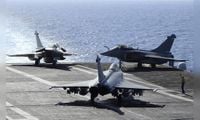Tensions between India and Pakistan have surged to their highest levels in years following the Pahalgam terrorist attack on April 22, which left 26 dead. In a decisive response, the Indian armed forces launched Operation Sindoor in the early hours of Wednesday, May 7, 2025. This operation involved a series of precision strikes targeting nine terror camps across Pakistan and Pakistan-occupied Kashmir. India described these actions as "focused, measured, and deliberately non-escalatory," aiming to hold the perpetrators accountable while avoiding direct attacks on Pakistani military facilities.
As the situation escalates, official statements and media briefings are saturated with technical military jargon, making it challenging for the public to fully grasp the unfolding events. To help decode the language shaping this crisis, here’s a primer on the technical terms being frequently used by both sides. These definitions aim to clarify the strategic concepts and operational buzzwords dominating the headlines.
First, we have SEAD, which stands for Suppression of Enemy Air Defences. This mission aims to destroy or disable the enemy’s air defence systems, such as surface-to-air missile launchers or radar sites, allowing friendly aircraft to operate safely. For instance, before launching a deep airstrike into enemy territory, the Indian Air Force might send aircraft equipped with anti-radiation missiles to knock out Pakistani radars and missile batteries — this is a SEAD operation. On Thursday, May 8, India confirmed that it conducted SEAD/DEAD (Destruction of Enemy Air Defences) operations to weaken Pakistan’s air defences.
Another term making waves is the "off-ramp." This refers to a diplomatic or strategic option that allows one or both sides to exit the conflict without appearing to have lost. It’s a way to de-escalate tensions while saving face. An example of this occurred after the 2019 Balakot airstrikes when Pakistan released a captured Indian pilot, which acted as an off-ramp, easing tensions and preventing further escalation.
Escalation, on the other hand, is the process of increasing the intensity of a conflict, either by using more force, expanding targets, or involving new weapons systems. If the conflict starts with artillery shelling across the Line of Control (LoC) and then progresses to airstrikes on military bases deep inside each other’s territory, that’s an escalation. Conversely, de-escalation is the reduction of the intensity of the conflict, which can occur through a ceasefire, diplomatic talks, or mutual military pullbacks. For example, both armies agreeing to halt cross-border firing and beginning talks at the diplomatic level is a form of de-escalation.
Furthermore, the "escalation ladder" is a conceptual model coined by American physicist Herman Kahn, describing how a conflict can increase in stages from low-intensity engagements to high-intensity warfare. Each step up the ladder represents a more serious and dangerous stage of escalation, ranging from troop movements near the border to missile deployment and nuclear posturing.
Additionally, loitering munitions are a type of drone or weapon that can "wait" in the air over a target area and attack when the opportunity arises. Often referred to as "suicide drones," they destroy themselves upon hitting the target. If Indian forces detect movement of a Pakistani mobile missile launcher but don’t know its exact location, they might deploy loitering munitions to hover over the area and strike as soon as it appears.
In the backdrop of these military operations, the technological capabilities of both nations are also critical to understanding the current dynamics. India's surface-to-air missile (SAM) capabilities include systems like Akash, Barak-8, and VL-SRSAM, designed to intercept and neutralize various aerial threats, including aircraft, missiles, and drones.
On the other side, Pakistan's air defence relies heavily on the HQ-9 missile system, a medium-to-long range air defence missile system developed by China. This system is designed to track and destroy aircraft, cruise missiles, air-to-surface missiles, and tactical ballistic missiles. The HQ-9 has a range of up to 200 km and a maximum speed of Mach 4.2, making it a formidable asset in Pakistan's defence arsenal.
Moreover, the SCALP missiles, which are long-range air-launched projectiles designed for pre-planned attacks against high-value stationary targets, are also noteworthy. These missiles utilize stealth coating and terrain-following flight paths, making them difficult for radar systems to detect.
As the conflict continues to escalate, the implications for regional stability are profound. Both nations have demonstrated a commitment to their military capabilities, which raises concerns about potential miscalculations that could lead to broader conflict.
In this tense atmosphere, the international community watches closely, hoping for a resolution that avoids further bloodshed. The stakes are high, and the consequences of missteps could reverberate beyond South Asia, affecting global security dynamics.
Ultimately, understanding the terminology and technology involved in this conflict is essential for grasping the broader implications of the ongoing tensions between India and Pakistan. As both nations navigate this precarious situation, the need for clear communication and diplomatic engagement is more critical than ever.




